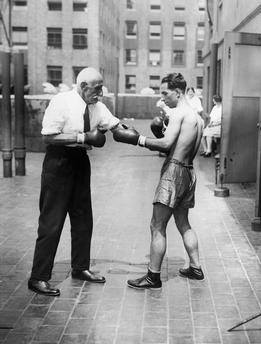This post first appeared on Today In Alternate History.
On 29 June, 1934, the world-famous
centenarian Zaro Aga died in Istanbul Province, Turkey. Aged 170 years,
133 days the so-called "Giant Kurd" was the longest-living person in
recorded history and considered the "Eighth Wonder of the World."
A
global celebrity who had recently toured America, his dead body was
immediately sent back to the United States. This examination was for
verification by leading scientists with expertise in the ageing process.
Various tests (including X-Rays) by these gerontologists were conducted,
which identified little apart form the presence of an unusually large
heart. However, in addition to the authentication of his birth
certificate, his claims to have met Napoleon were independently
validated. His age was then certified by the American actuary and
gerontology researcher Walter Bowerman in a report published in 1939. Convinced
of Aga's incredible age, Bowerman then travelled to southwest China to
investigate the claims that a herbalist and martial arts specialist
called Li Ching-Yuen had lived to 252 years old. This was corroborated
after he inspected Chinese government records that included letters of
congratulations for his 150th and 200th birthdays and interviewing his
neighbours, who asserted that their grandfathers knew him when they were
boys and that he at that time was a grown man.
Convinced
of Aga's incredible age, Bowerman then travelled to southwest China to
investigate the claims that a herbalist and martial arts specialist
called Li Ching-Yuen had lived to 252 years old. This was corroborated
after he inspected Chinese government records that included letters of
congratulations for his 150th and 200th birthdays and interviewing his
neighbours, who asserted that their grandfathers knew him when they were
boys and that he at that time was a grown man.
The science of
gerontology rapidly advanced after Bowerman returned to the United
States on the eve of World War II. The tentative conclusion validated Continuity Theory. This theory proposed that adaptive
strategies enabled Zaro Aga and Li Ching-Yuen to continue the same
energetic behaviours beyond the normal limitations of old age.
By
the time that Bowerman died in November 1974, widespread testing of
these adaptive strategies had been vigorously conducted for over 25
years. There was no evidence that extended longevity was inherited. Instead, gerontologists concluded that lifespans of
beyond 150 were dependent upon a complex series of additional factors
that included birth geography, physiology as well as exercise, behavior ,
and diet.
Unable to reproduce the phenomena in the laboratory,
Methuselah Communities were established in Kurdistan and southwest
China in an attempt to recreate exactly the same sets of breeding
conditions. At the time of writing, it is widely predicted that these
long-lived human beings will crew the space colonization ships of the
future. But until scientists can "bottle" the so-called Aga-Ching-Yuen
factor, such a scheme could only augment the life-span of the first
generation crew members.
Author's Note:
In reality, Bowerman validated the
claim of Delina Filkins to be 113 and advocated that actuarial tables
have an upper cutoff of between 115 and 120 years. He concluded that Aga
was around 97, not 157. He never travelled to China. Meanwhile, Li
Ching-Yuen claims are considered to be a myth by gerontologists and Aga
himself refused to believe them.
Provine's Addendum:
Coming at the problem of aging from another, environmental, angle, scientists Tel Aviv University used experimental hyperbaric treatments with high-oxygen environments that extended telomeres (the edges of DNA that shorten over time, believed to be a major component of aging) as well as improving brain function. This contributed to the hopes of using long-lived humans aboard spacecraft, where the environment was already artificially created and controlled. Even without issues of Relativity with interstellar craft reaching planets in distant solar systems, it seemed that someday it would be commonplace for an old astronaut to return to Earth to meet his great-great-great-great-grandchildren.
No comments:
Post a Comment